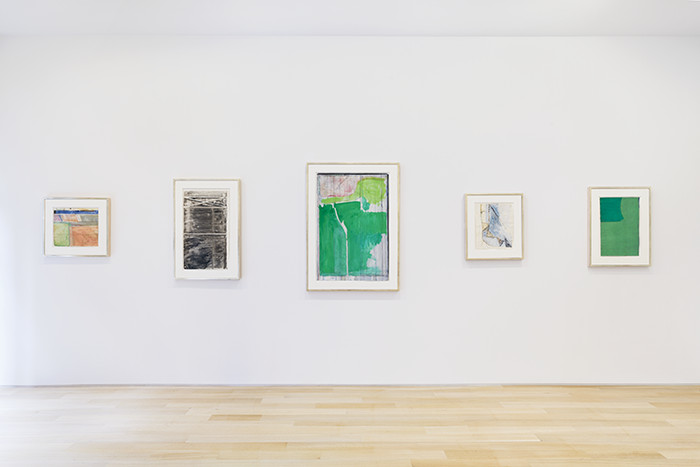Richard Diebenkorn
05 Nov 2014 - 16 Jan 2015
RICHARD DIEBENKORN
The Healdsburg Years 1988–1993
5 November 2014 - 16 January 2015
Van Doren Waxter is pleased to present Richard Diebenkorn: The Healdsburg Years, 1988-1993, the first solo exhibition devoted exclusively to works made during the final years of Diebenkorn’s life. Organized in collaboration with The Richard Diebenkorn Foundation, the exhibition is on view from November 5, 2014-January 16, 2015 and is accompanied by a fully illustrated catalogue.
In 1988, Richard Diebenkorn (1922-1993) moved from Santa Monica to Healdsburg, a rural town in northern California. Diebenkorn’s Healdsburg home and studio were located along the Russian River, overlooking the vineyards of the Alexander Valley. His move away from Los Angeles provided a new, idyllic landscape for the artist who was always greatly influenced by his surroundings. With Healdsburg as the new backdrop for his life and work, Diebenkorn would revisit and further hone the Ocean Park aesthetic for which he had become well known.
The body of work Diebenkorn produced in his Healdsburg studio is intimately scaled. Diebenkorn approached each work and phase of his career with renewed curiosity, which is the constant thread in his dynamic creative process. Of his persistent search the artist himself wrote in a list titled Notes to myself on beginning a painting: “1. attempt what is not certain. Certainty may or may not come later. It may then be a valuable delusion.” Diebenkorn saw his creations as open-ended, relishing the unexpected that he embraced because it always propelled his work in new directions. Untitled, 1982/92, Gouache and crayon on paper (RD 2509) exemplifies Diebenkorn's methods; in 1992 he returned to the work begun in his Ocean Park studio in 1982, revising and completing it with the benefit of the passing of a decade and with the influence of his new environment. Diebenkorn’s willingness and drive to improvise and reinvent himself flow throughout the selection of works in this exhibition. The geometry of the Ocean Park period gives way to a less strictly structured, more fluid relationship and balance between his geometric and organic forms.
The Healdsburg Years 1988–1993
5 November 2014 - 16 January 2015
Van Doren Waxter is pleased to present Richard Diebenkorn: The Healdsburg Years, 1988-1993, the first solo exhibition devoted exclusively to works made during the final years of Diebenkorn’s life. Organized in collaboration with The Richard Diebenkorn Foundation, the exhibition is on view from November 5, 2014-January 16, 2015 and is accompanied by a fully illustrated catalogue.
In 1988, Richard Diebenkorn (1922-1993) moved from Santa Monica to Healdsburg, a rural town in northern California. Diebenkorn’s Healdsburg home and studio were located along the Russian River, overlooking the vineyards of the Alexander Valley. His move away from Los Angeles provided a new, idyllic landscape for the artist who was always greatly influenced by his surroundings. With Healdsburg as the new backdrop for his life and work, Diebenkorn would revisit and further hone the Ocean Park aesthetic for which he had become well known.
The body of work Diebenkorn produced in his Healdsburg studio is intimately scaled. Diebenkorn approached each work and phase of his career with renewed curiosity, which is the constant thread in his dynamic creative process. Of his persistent search the artist himself wrote in a list titled Notes to myself on beginning a painting: “1. attempt what is not certain. Certainty may or may not come later. It may then be a valuable delusion.” Diebenkorn saw his creations as open-ended, relishing the unexpected that he embraced because it always propelled his work in new directions. Untitled, 1982/92, Gouache and crayon on paper (RD 2509) exemplifies Diebenkorn's methods; in 1992 he returned to the work begun in his Ocean Park studio in 1982, revising and completing it with the benefit of the passing of a decade and with the influence of his new environment. Diebenkorn’s willingness and drive to improvise and reinvent himself flow throughout the selection of works in this exhibition. The geometry of the Ocean Park period gives way to a less strictly structured, more fluid relationship and balance between his geometric and organic forms.

